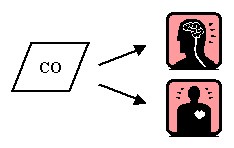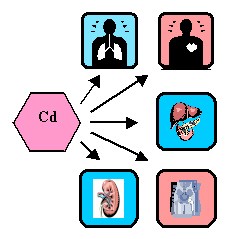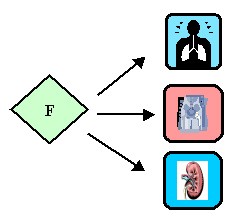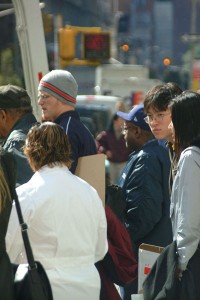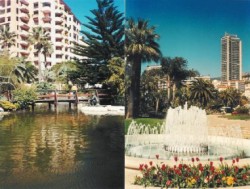 > English > Climate Encyclopaedia > Climate in Cities > more > 2. Urban Climate > - Bioclimate
> English > Climate Encyclopaedia > Climate in Cities > more > 2. Urban Climate > - Bioclimate
|
Climate in citiesRead more |
The urban bioclimateBioclimatology is a branch of science dealing with the impact of weather and climate on all living organisms, including humans. In cities we are exposed to chemicals from air pollution, higher than average temperatures as a result of the urban heat island effect and noise from traffic and industry. As a result, the urban climate may be harmful to our health.
|
|
Air pollution and noise are the cause of the most important health problems in cities. Poor air quality directly affects our health. Vehicles only emit around 20% of the air pollution in cities. However, because the pollutants are emitted directly into the streets where people live and work, the impact of vehicle emissions on human health is large. Examples of typical urban air pollutants and their influence on human health are given below.
|
|
|
|
Nitrogen oxides (NOx) decrease blood pressure, decrease the efficiency of the lungs and cause eye irritation. The main source of NOx in urban air is the combustion of fossil fuels, particularly in vehicles, but also in power stations and from the chemical industry. |
The presence of carbon monoxide (CO) in urban air increases the risk of heart attack, coronary disease and diseases of the circulatory system. Moreover, it replaces oxygen in the blood and causes oxygen deficit in the body which may lead to damage of the nervous system and brain and even death. The main source of CO in urban air is the incomplete combustion of fossil fuels such as coal, oil and natural gas.
|
|
|
|
Another heavy metal, lead (Pb), accumulates in our bones and affects our kidneys and nervous system where it can cause mental illness. It is toxic to our liver and damages our eyes. Petrol used to be the main source of lead in urban air but since leaded petrol is no longer used, the main sources of Pb are now the metal processing industry and coal combustion. |
|
|
|
Tropospheric ozone (O3), which is formed, for example, during photochemical smog episodes, irritates our eyes and our respiratory system. High levels may even partially destroy our upper respiratory tract. The origin of tropospheric ozone is described in the text on "Ozone smog". |
|
|
Volatile Organic Compounds (VOC's) have both natural and human sources. Some may be beneficial to our health as they can kill bacteria present in the air. Others, however, may cause lung cancer. VOC's, along with NOx, play an important role in the formation of tropospheric ozone. The VOC-to-NOx ratio governs how much ozone is formed. Increasing VOC concentrations means more ozone, increasing NOx leads to either more or less ozone depending on the VOC-to-NOx ratio already present in the air.
|
|
The presence of air pollutants decreases the air quality in a city. Some pollutants react to form acid rain and this then pollutes groundwaters and soils. Air pollution also decreases the amount of solar radiation reaching the ground by 10-30%, especially in the ultra-violet range. Lower levels of ultra-violet radiation may reduce the production of vitamin D in humans and this can lead to bone problems and a disease called rickets.
|
NoiseRecently noise has been included in the factors which significantly affect living conditions in cities. Noise has a negative impact on our nervous system and hearing. According to the World Health Organization, more than half of the citizens of Europe lived in noisy surroundings in 2001 and a third experienced noise levels which disrupted their sleep. The main sources of noise are vehicles, industrial production and commerce. The impact of noise on human health depends on its intensity, frequency and duration. People living in cities are often exposed to noise and therefore suffer from headaches and problems with sleeping and this can reduce their efficiency at work. Constant noise between 71 and 85 decibels causes permanent hearing loss. When the intensity increases to between 86 and 130 decibels, the main functions of human body are disturbed. The value of 130 decibels marks the threshold of physical pain.
|
|
The urban heat islandThe urban heat island (UHI) has a mostly negative impact on people. Human thermal comfort is controlled by a combination of thermal stimuli, i.e. short- and long-wave radiation, heat fluxes, air temperature, humidity and wind. People in cities often feel too hot in the summer due to the higher than average temperatures (resulting from increased heat absorption by building materials, by heat emitted during human activities and also as a result of low wind speeds in the city centres which prevent fresh air entering the city). This is intensified when the air temperature is higher than 17 oC, the relative humidity is greater than 85%, the air pressure is more than 18.8 hPa and the windspeed is close to zero. Under these conditions, the weather is described as "sultry". This sultriness causes worse thermoregulation in our bodies as it slows down evaporation of sweat. Sweating cools down our body and protects us from overheating.
|
|
Humans have a great ability to adapt to changing temperatures. When our body temperature increases, the blood-vessels widen, more blood can be transported and this helps us to cool down. In addition, we sweat more. We use heat from our body to evaporate the sweat and this cools us further.
|
To reduce the negative impact of the urban climate on people, we need to increase the amounts of parks and lawns in cities. Green areas "filter" the air and air pollution can be lower in a park by as much as 20 to 40% in comparison with the rest of the city. Plants produce oxygen which improves the air quality. In summer, green areas also decrease air temperature by shading the ground (less solar energy reaches the ground, so less is absorbed by the surface and radiated back to the air as heat). As a result of this shading, soil surface temperatures in a park may be 12 oC lower than the temperature of a street surface. City parks decrease air temperature by about 15% compared to the rest of a city. Green areas also increase air humidity, reduce thermal stress, enhance local air circulation, deaden noise and improve our quality of life.
|
|
|
Related pages: The urban heat island is discussed in detail in:
|
|
About this page:Authors: Sebastian Wypych, Anita Bokwa - Jagiellonian University - Cracow / Poland |



